This time last year, the province was readying itself for a major policy announcement following a surge of protests in Fairy Creek.
The announcement consisted of a slate of deferrals Premier John Horgan promised would “fundamentally transform the way we manage our old-growth forests, lands and resources.” These deferrals were made, Horgan said, following recommendations from a 2021 report by the Old Growth Technical Advisory Panel.
Behind the scenes, however, the province’s top forestry executives had actually been trying to block some of the panel’s findings.
Internal communications released to The Tyee through access to information laws, as well as interviews with panel members, show the province attempted to limit the information about B.C.’s remaining old growth that would be shared with the public.
Some of the province’s attempts were successful.
Looking at the numbers
When the advisory panel publicly released their findings in November 2021, they unveiled a critical number: how much old growth naturally existed in the province before industrial forestry — 25 million hectares. Of that, they found that only 11 million hectares remained.
But an email exchange The Tyee uncovered through a freedom of information request shows B.C.'s then-chief forester, Diane Nicholls, didn’t want the historic number published.
“The timeline is prior to climate change and a long time ago,” she said, adding in another email that the figure was not realistic.
Then she planted a seed for its removal: “Is there any way not to use it?”
For Karen Price, an ecologist and member of the Technical Advisory Panel, Nicholls’ request circumvents the point.
“You need a baseline, otherwise it’s meaningless,” said Price, noting what was there initially is critical to establish how much old growth to protect, not “what was there last year,” she said, adding that the number was based on their own and others’ peer-reviewed research.
Nicholls has since left her position as chief forester and now works as the vice-president of sustainability in North America for Drax, the province’s largest wood pellet company. Drax did not respond to The Tyee’s request for comment.
In an emailed statement to The Tyee, the province said “it would not be appropriate for the ministry to speak on behalf of a former employee,” but added that “Declines in the area of old-growth forest are not simply a function of historical logging. Given the changing climate, increased forest health outbreaks and fire frequency, the 25 million hectares figure would likely be significantly lower today even if logging had never occurred.”
It further noted that the 25 million hectare figure was based on “assumptions” but that the current old-growth total calculated by the Technical Advisory Panel is “based on verified forest inventory data.”
Garry Merkel, a registered forester member and member of the same Technical Advisory Panel, suggests that Nicholls’ concern instead could have been that the 25 million hectare figure was too broad to work with, adding that it includes old-growth forests outside the timber harvesting land base — in other words, the area where it’s legal and economical to log — which is her sole jurisdiction. “For a forest manager, it’s a tough number,” he said.
In the end, the figure was included in the advisory panel’s report.
‘An interesting dance’
According to Price and fellow panel member David Daust, the government's attempt to shape the Technical Advisory Panel’s findings extended beyond whether to include the 25 million hectare figure.
They say government removed, for example, information about how many hectares of potentially deferred forests were actually threatened by logging because they are in the timber harvesting land base. Price and Daust report including that information in a draft of their final report, but say the province took it out.
“It was a bit of an interesting dance,” said Daust. “They kept saying, you guys are writing this. This is your work.... But when it came to putting our report out, there were bits that they wouldn't let us put in there.”
When The Tyee asked the province about this removal, the province responded, “TAP operated as an independent group. Their recommendations and report were published as received,” but did not directly address the question. After the publication of this article, the province pointed out that the 1.2 million hectare overlap between the proposed deferrals and the timber harvesting land base was included in a technical appendix published in February.*
Price and Daust also say the province removed figures from the panel's report that showed the percentage of deferrals that overlapped with the timber harvesting land base slated for each region.
In an emailed statement, the Ministry of Forests responded to Price and Daust’s allegations by linking to the panel’s terms of reference, and stating that the panel’s “recommendations and report were published as received.” It did not comment on whether earlier drafts had been changed.
For Price, that singular focus reduced transparency around the deferral process and how much logging stood to be paused. “You don't need to defer anything that's outside the [timber harvesting land base],” she said. “There’s no point.”
In the October 2021 email exchange The Tyee obtained through a freedom of information request, Nicholls shared that ministry staff had competing ideas around the amount of deferrals to emphasize publicly.
In one conversation, Nicholls flagged that one colleague “only wants to use the [redacted] number of deferral sites that are the actual permits.”

“I am also concerned about just using the [redacted] number,” said Associate Deputy Minister Eamon O’Donoghue in a response. “It feels misleading and when the industry picks up on it, gov[ernment] will get slammed.”
According to the Ministry of Forests, O’Donoghue was concerned that the province might be “underreporting” the impact of deferrals. That’s because if the province actually made old-growth deferrals beyond just the current logging permits, companies would be barred from applying for new licenses as well as potentially halting their current logging activity in deferral areas.
A message tailored for the public
In the end, O’Donoghue’s concerns were unfounded, because government chose to highlight the larger 2.6 million hectare figure in the rollout of the deferrals.
“Deferring harvest in an area this large is unprecedented, and surpasses the size of 226 cities of Vancouver,” said Forests Minister Katrine Conroy during the November 2021 announcement.
But only about half of that total was in an area where logging could occur, and an even smaller fraction — 48,000 hectares — overlapped with current cutting permits.
That permit overlap was included as a line item in the Technical Advisory Panel’s report, and the total area of deferrals in the timber harvesting land base was eventually disclosed a month later in a December press release.
“From the perspective of the government, there's benefits and drawbacks of framing the deferrals as the amount of logging actually stopped and the amount of deferral you say you're doing,” said Torrance Coste, national campaign director of the Wilderness Committee.
Coste has been critical of government’s tendency to “inflate” the area of deferrals by including areas that would never be logged.
A year later, the government has in fact come under fire for logging in deferral areas.
The province enacted immediate deferrals in the forests it controlled through its own logging arm — BC Timber Sales, amounting to about 258,000 hectares, as reported by Brenna Owen for the Canadian Press.
But for the bulk of the proposed deferrals, amounting to 2.3 million hectares, the province said it would wait for approval from nations whose territories include the land in question.
That approach was met with mixed reviews from First Nations and First Nations organizations. Groups like the BC First Nations Forestry Council supported the decision to wait for nations’ consent to deferral. Others, including the Union of British Columbia Indian Chiefs called for deferrals to be established immediately. Both groups wanted more resources to support nations considering deferrals, and more shared jurisdiction with nations over old-growth policy, contrary to the rollout, which saw many nations informed of the plan at the same time as the general public and given a suggested 30-day timeline to decide on the deferrals.
In its announcement, the province laid out $12.69 million in “capacity funding” to support nations with consulting and negotiation fees. That figure did not include enough compensation for nations for the expense of lost revenue due to decreased forest activity in their territories.
In their emailed statement to The Tyee, the province added that its 2022 budget included $185 million over three years to support “workers, communities and First Nations impacted by old-growth deferrals and help offset any short-term economic impacts” but it would not clarify whether that includes direct compensation.
Today, the province has still not indicated which as-yet-undeferred areas are at imminent risk of being logged. In a subsequent email, the Ministry of Forests said that “the province is respecting the confidentiality of G2G [government-to-government] engagements with First Nations.”
The ministry clarified that less than 0.4 per cent of the total 2.6 million hectares recommended for deferral had been logged since November 2021. In a subsequent email, the province stated that total to be 9,300 hectares. That’s over 3,000 hectares more than the province reported to the Canadian Press this May.
Price thinks the province should have prioritized transparency in its approach to the Old Growth Technical Advisory Panel review report and its subsequent messaging to the public.
“I believe that governments need to be responsible for their actions, they need to be transparent,” she said. “If you're going to do something that puts biodiversity at high risk, you need to tell the public that.”
* Story updated on Nov. 15 at 3:22 p.m. to add information received from the province after publication. ![]()
Read more: Indigenous, BC Politics
















Tyee Commenting Guidelines
Comments that violate guidelines risk being deleted, and violations may result in a temporary or permanent user ban. Maintain the spirit of good conversation to stay in the discussion and be patient with moderators. Comments are reviewed regularly but not in real time.
Do:
Do not: